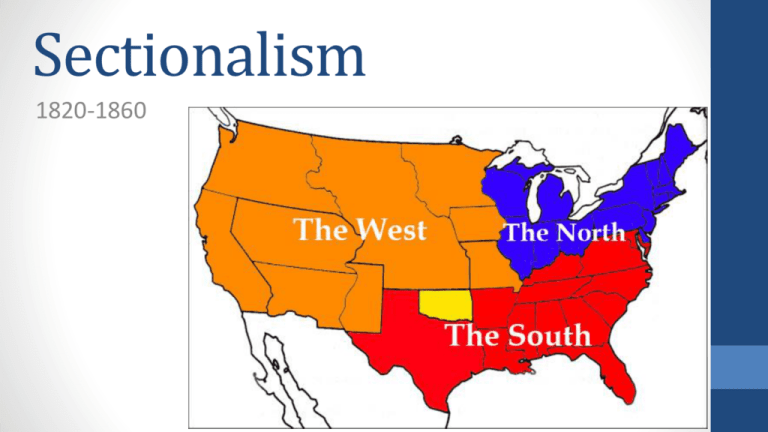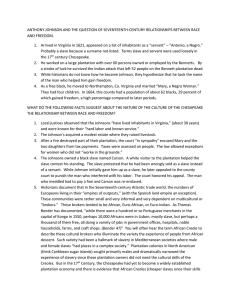Sectionalism in the US 1820-1860: North, South, West
advertisement

Sectionalism 1820-1860 Essential Question • Compare and contrast the characteristics and influences of the three major sections of the United States by the mid-19th century. Causes of Sectionalism • Loyalty to region • Social & cultural differences • Economic differences • Federal vs. States’ Rights The North • Northeast, Mid-Atlantic, and Old Northwest • Commonalities: • Bound by transportation advances • Industrialization and commercial farming • Prohibition of slavery (most) • Characteristics: • Most populous • High birthrate • Large # of immigrants • Industrial Northeast • Organized Labor • National Trades’ Union (1837) - failure • Urban Life • expansion of population —> expansion of slums • poor sanitation, disease, high crime rates • African Americans • 1% of population but 50% of free blacks • 2nd class, non-citizens The Agricultural Northwest • Old Northwest (OH, IN, IL, MI, WI, MN) • Tied to North East as result of: • military campaigns against Indians • building of canals and railroads • Agriculture • New inventions lead to expansion • McCormick reaper, Deere steel plow • New Cities • Buffalo, Cleveland, Detroit, St. Louis, Chicago • distribution/shipping points Immigration • Causes of Influx: • inexpensive and expedited ocean travel • famines and political unrest (push) • economic opportunity in U.S. (pull) • Largest Groups: • Irish • potato famine • settled in cities • NY, Boston, Philadelphia • identified w/Democratic party • influence of/on Tammany • Germans • Revolutions of 1848 and economic hardships • settled in rural areas of Old Northwest • pro-public education • anti-slavery Nativism • Reaction to: • Immigrant culture: • Catholicism (Irish) • Alcohol (Irish & Germans) • Political strength • Manifestations: • Supreme Order of the Star Spangled Banner • American Party - “KnowNothings” • Riots in cities The South • Agriculture and King Cotton • continued importance of cash crops and plantation system • only 15% of industrial production • impact of cotton gin • Slavery, the “Peculiar Institution” • Population Growth: 4 million (1860) • all natural • slave trade ended in 1808 • although some smuggling occurred • Higher demand in Deep South • majority of slaves now on plantations/large farms (opposite of early period) Nature of Slavery • Slave Life • varied by plantation • harsh to humane treatment • development of slave culture • religion • slave hymnals • retention of kinship • Resistance • Routine: slowdowns, sabotage, escape • Uprisings/Rebellions: • Vesey (1822) • Turner (1831) • Effects: • Southern States tighten strict slave codes • Polarized nation: • Northerners became critical of institution • Southerners became more defensive Southern Society • Free African Americans • Roughly 250,000 • could own property • could not vote • had to prove status • White Society • Rigid Hierarchy • Aristocracy (Planters) • Farmers • Poor Whites • “Mountain People” • Cities • small populations compared to North • Southern Thought • Code of Chivalry • Education • higher education only for the wealthy • Religion The West • American Indians • Exodus to Great Plains • Impact of the Horse • Major Tribes: • Cheyenne • Sioux • The Frontier • Mountain Men • Beckwourth, Smith, Bridger • The Homestead • White Settlers • Role of Women • Environmental Damage • land • wildlife




